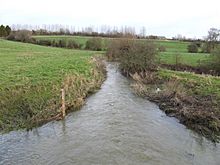River Cole, Wiltshire facts for kids
Quick facts for kids River Cole |
|
|---|---|

Cole near Sevenhampton
|
|
| Country | England |
| Counties | Wiltshire, Oxfordshire |
| Towns | Swindon |
| Physical characteristics | |
| Main source | Swindon, Wiltshire 51°34′21″N 1°43′31″W / 51.5726°N 1.7252°W |
| River mouth | River Thames Above Buscot Lock, Oxfordshire 51°41′19″N 1°40′37″W / 51.68861°N 1.67694°W |
The River Cole is a small but important river in England. It flows through the counties of Wiltshire and Oxfordshire. For part of its journey, it even forms the border between these two areas! The River Cole eventually joins the much larger River Thames.
Where Does the River Cole Flow?
The River Cole starts in Swindon, a town in Wiltshire. It begins west of the town centre in an area called Walcot. A lot of its early path is hidden underground or has buildings on top of it.
You can see the river east of the Greenbridge retail park. From there, it flows northeast. It then goes underground again before turning southeast near Slade Drive. It flows in this direction for about three-quarters of a mile.
At the Piccadilly roundabout, the river turns sharply east. It then flows along the edge of the Coleview Estate. It continues east past Covingham and under Merlin Way. The river then passes through a flood marsh. After that, it goes under the A419 road.
The River Cole flows to the east of Swindon. It passes through places like Stratton St Margaret, South Marston, and Coleshill, Oxfordshire. Finally, it joins the River Thames near Lechlade. This meeting point is on the southern bank, close to the A417 bridge. This is just above Buscot Lock on the Thames.
Part of the river flows through land owned by the National Trust. In the past, many mills were built next to the river. These mills changed the river by making it straighter and causing pollution.
How the River Cole Was Restored
In the 1990s, the River Cole was quite polluted. People decided to help it become healthy again. Near Coleshill, they worked to restore the river. This meant letting it flow more naturally. They also improved the river bed.
The goal was to increase the number of different living things in the area. This is called increasing biodiversity. It also aimed to make the river itself healthier.
Here are some of the things they did:
- They raised the river bed. This helped create natural flood meadows and floodplains. These areas can hold extra water when the river floods.
- They added meanders. These are natural curves and bends in a river. They help to slow down the water and create different habitats. This helps to make the river environment more natural.
These changes also help local people. By allowing flooding further upstream and in nearby fields, the risk of floods in towns decreases. The restoration work was done in 1995. It was part of a special project by the River Restoration Project.
Flooding in 2007
In July 2007, there were very heavy rains. The River Cole burst its banks. This means the water flowed out of the river and onto the land. The Covingham area of Swindon was flooded. Covingham Drive, which is just south of the river, was also affected.
After this flood, a lot of work was done. These "remedial works" were carried out to reduce the chance of future flooding.

